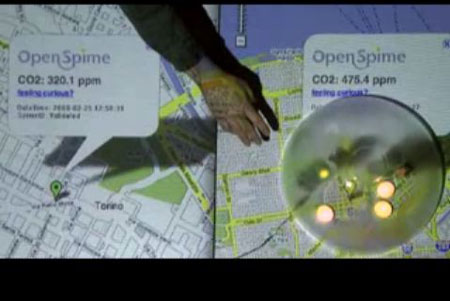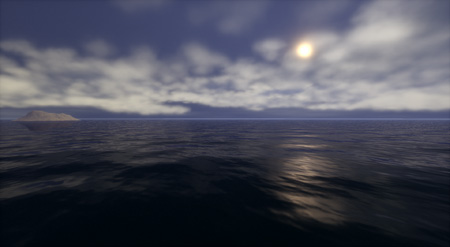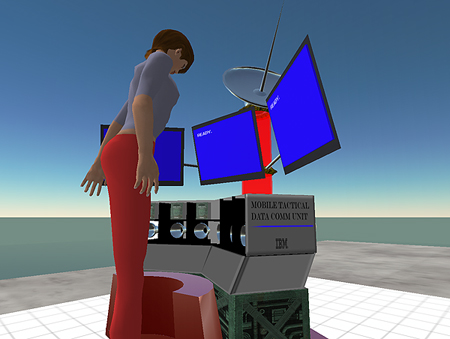We have built the technology for monitoring almost everything, almost everywhere and we are making 99% of it open-source. Thanx to Bruce Sterling who inspired us, we called our technology “OpenSpime.†This is a concrete opportunity to monitor the earth, and everyone on this planet will be able to contribute to this.
OpenSpime have prepared a concept video of CO2 monitoring (still from the video above) and Google maps mashup via their OpenSpime infrastructure. For more see, co-founder, David Orban’s post OpenSpime: What do you know about your planet?
Instrumentation versus Surveillance
Surveillance is all about when people in authority know a lot about you. Instrumentation is when you know a lot about the world. And it allows you have more agency. When people know a lot about you it takes away your agency.
Cory Doctorow, Craphound.com, boingboing.net
OpenSpime and SL Data Viz project (a project in Second Life “where people can contribute, review and copy open-source data viz tools” which OpenSpime will participate in) are taking up the challenge that Bruce Sterling made at end of his visionary book, Shaping Things. Sterling gave an imperative to humankind to start to make “decent technology” – social software entities that can answer questions. Questions about our world. Questions about objects. Not the profit-centric questions – serious questions. (Shaping Things).
The protagonists of this new era of social software – the narrators of the instrumented world to come – are Spimes.
Sterling invented the term by compressing ‘space’ and ‘time’. Spimes are aware of their environment, they know where they are, and when they are, and keep track of some parameter around them. Sensing, memory, and ubiquitous communication enable spimes to accurately map the physical world around them. The progressive saturation of the world with spimes is creating what is called the Internet of Things.
The closing words of Sterling’s great visionary book on “spimes†and “the internet of things†are:
Its not enough to think about that, or even write about. If it is to be any use to humankind, it will have to get done.
OpenSpime is doing it! SL Data Viz project is doing it!
If you are not yet in tune with “the internet of things†here is a music video Royksopp’s “Remind Me†that Sterling suggests is some kind of “spime†theme song. This is the third time I have posted this link but Spimes deserve all the air play they can get!
Our technology enables individuals and corporations to better understand their environment, through the use of a series of GPS-enabled sensors. We provide a set of open APIs and communication protocols to manage the data collected.
See an interview with the founders of OpenSpime here.
With free hardware, free software, open APIs and communication protocols, OpenSpime’s business model is about the provisioning of the SpimeID identification numbers for the trusted communication of validated data streams between spimes and the OpenSpime servers.
Here are David’s responses to questions about the revenue model:
The revenue model is based on the sale (in large quantities to the hardware makers) of the certified SpimeIDs. Anybody can build spimes that conform to our open specifications, but if you want us to validate the data that your spime collects, and aggregate it together with other trusted sources, than you have to pay €1 per device to get the ID. Ah, and we already have LOIs for several hundred thousand IDs to be built in devices. [smile]
The estimates are that there will be ten or more spimes per person in the developed countries within ten years. That is approximately 25 billion spimes, and counting, since by 2020 the number of people who live in countries we define developed will also increase. That’s a
market for you! And we want to define the way the data generated is managed.What comes after humans twittering to each other? Spimetalk. And spimetalk is going to be several orders of magnitude more intense than any human2human or human2machine communication before that.
From Spimes to Mirror Worlds
Agents, avatars and spimes will eventually hang out together in Virtual Worlds, interacting in real time in networked virtual environments built of live data and 3D info machines.
Melanie Swan points out:
Virtual Worlds have been used for architectural builds and interaction and the next obvious step is making them alive with data, streaming in data and representing it visually. Data visualization in Second Life is starting to take off with an open-source movement to make open-source building-block tools available to the community and developers and end users creating specific-purpose enterprise and science applications. There is a community wiki and a “Data Visualization” group in Second Life.
The picture above is of a Bashiba Panorama – “a commercially available ambient data panorama that dynamically reflects the overall “mood” of a rich information environment. The so-called “data atmosphere” reacts in real-time multivariable changes (e.g. stock market data), that are then mapped to visual counterparts (e.g. ocean waves, sun strength, wind speed, rain). the resulting information display can be interpreted ‘without cognitive effort’.”
“once the stock market opens, our 3D simulation comes to life, & people start ‘breathing’ business information.”
The streaming Bashiba Panorama in Second Life is an experiment in collaboration with Melanie Swan (MS Futures Group) and powered by the Ohio University VITAL Laboratory streaming server (many thanks to Dr. Chang Liu + Stephen Carroll). Look for Bashiba to come to Second Life in full immersive 3D!
For videos of Bashiba in SL see here and here.
3D Command Centers the killer app of the 3D Internet
A Mobile Tactical Data Comm Unit built by Illuminous Beltran in OpenSim
Data visualization will develop increasingly into and become inextricable from operation/command centers – the 3D information machines that will reinvent the relationship between humans and the up to now invisible but most crucial layer of modern society – software. For more on Illuminous Beltran’s, (a.k.a Michael Osias, IBM) virtual operation centers/command centers in Second Life/OpenSim see here.
These 3D command centers are being used for energy management, virtual network operations centers, and for building automation (see the work of Eolus). But, as long as our society is wedded to war, the “killer app” of the 3D internet will also be a killer app in more ways than one. The instrumentation of society has grown up hand in hand with surveillance and military technology. But it is up to us, as a society, to grow the peaceful and people centered aspects of this technology.
The nascent spiming technology of RFID had its roots in military innovation.
In 1946 Léon Theremin invented an espionage tool for the Soviet Union which retransmitted incident radio waves with audio information. Sound waves vibrated a diaphragm which slightly altered the shape of the resonator, which modulated the reflected radio frequency. Even though this device was a passive covert listening device, not an identification tag, it has been attributed as a predecessor to RFID technology. The technology used in RFID has been around since the early 1920s according to one source (although the same source states that RFID systems have been around just since the late 1960s).[2][3][4][5]
Similar technology, such as the IFF transponder invented by the United Kingdom in 1939, was routinely used by the allies in World War II to identify aircraft as friend or foe. Transponders are still used by military and commercial aircraft to this day. (for more see Wikipedia on RFID)
But, Gelertner’s vision in, Mirror Worlds 1991, is the transformation of computers into seeing machines that will empower people to understand and work with the machinery of their society. And with projects like OpenSpime everyone can contribute to the task of asking important questions about our world. And as these questions are increasingly incorporated in virtual operation centers, we will be able to interact with the previously invisible machinery of our modern world – tinker with it, hang out in it with other avatars, and agents, and command it in new ways.
Life2.0 Summit Spring ’08
Life 2.0 is the leading event on virtual world application and business development. Produced three times yearly by CMP in Second Life, the six-day virtual event draws a fully-registered, global audience of over 1000 software architects, creatives, CMOs and key executives seeking to harness the power of virtual reality for marketing, application creation, commerce, education, and to connect with the Net’s fastest-growing, smartest, most-engaged communities.
Also check out CMP’s John Jainschigg’s (John Zhaoying in Second life) post, “Life 2.0 – As green as Five Brazilian Households,” which demonstrates “that importing certain kinds of real-world activities into virtual reality saves a bagload of carbon. Or put another way, that it enables us to enjoy the benefits of global human community at small cost to the planet.”
Eben Moglen to join IPPI panel at Life 2.0 in SecondLife
The Kickoff Symposium will Discuss Opensource, IP and Privacy/Identity in Virtual Worlds On Sunday, March 16, at 1 PM PST.
Life 2.0′s IPPI (Intellectual Property, Privacy and Identity) symposium will kick off with a rousing panel discussion on Opensource, IP and Privacy in Virtual Worlds — including special guest Eben Moglen, Director, Chair and Chief Counsel of the Software Freedom Law Center. Moglen, professor of law and legal history at Columbia, is a pioneer of the opensource movement, former general counsel for the Free Software Foundation, and one of the architects of version 3 of the GNU GPL.
The panel (still growing!) will be moderated by Tish Shute (Tara5 Oh), who blogs on virtual worlds (hey that’s me!), and CMP’s John Jainschigg (John Zhaoying).
Also see, A Conversation with Eben Moglen on Second Life.
There will be a Data Viz panel at Life 2.0, Monday, March 17th, 2pm to 3pm PST, organized by Melanie Swan (more on this soon). See the impressive list of data visualization tools that SL Data Viz project has already gathered together below.
Directory of Data Visualization Tools in SL:
(excerpted from the sldataviz wiki)
Interactive Data Exhibits:
- Embodiment Island Data Visualization Exhibit Hall, SLurl, contact Mark Dubin/ThreeDee Shepherd to exhibit material
- NOAA real-time U.S. weather sim, SLurl
- Daden Prime real-time U.K. weather sim, SLurl
- Daden Prime real-time LAX Air Traffic Data, SLurl
Tools – scientific:
- CAIA – Cheminformatic Assisted Image Array visualization laboratory. Status: Available to view (Gus Rosania/Caia Alter), SLurl
- Hiro’s Molecule Rezzer – Rezzes molecules from a notecard. Status: OpenSLedware. (Andrew Lang/Hiro Sheridan) ONREZ SLurl
- Histogram (20 period, real-time, on-demand stock market data), SLurl. Status: Open-source download available (Melanie Swan/Xantha Oe and Eloise Pasteur)
- Orac – Takes smi, InChI, or inchikey as input, queries three web services and rezzes the returned minimized structure in SL. Status: Avaliable upon request. (Andrew Lang/Hiro Sheridan)
- StoryMachine – Generic visualization tool for dynamic interactions. Status: In development (Peter Miller/Graham Mills), SLurl
- StoryMachine – PubMed Search. Status: In development (Peter Miller/Graham Mills), SLurl
- Protein Rezzer Toolkit – In-world rezzing of 3D protein backbone structures based on specially parsed PDB files. Status: In development (Peter Miller/Graham Mills; based on scripts by Troy McLuhan).
Tools – enterprise:
- Airline flight booking – connecting Second Life to a SAP NetWeaver system to create a 3-D Business Process (Bjoernaeon). Also see Craig Cmehil’s blog.
- Green Phosphor, New Jersey, USA – enterprise data visualization applications (Ben Lindquist/Arkowitz Jonson, David Cooper/Coop Upshaw)






March 3rd, 2008 at 1:34 pm
Yes, Tish, we are doing it, and soon the world will be a different place. The planet has been talking to us, but we seldom listened. With the knowledge that we’ll gather through spimes acquiring data with an extremely high granularity, we’ll be empowered to act!